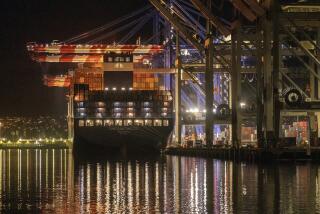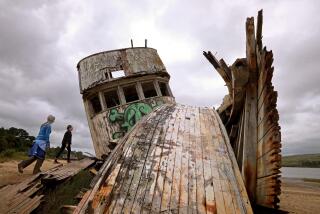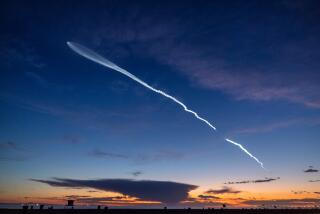‘Ghost Fleet’ Is No Energy Panacea
- Share via
BENICIA, Calif. — They loom just offshore in a brackish bay north of town, steel gray reminders of America’s maritime might. Row upon row of frigates and tankers and cargo ships recline in the choppy waters, basking in retirement.
Now the Suisun Bay Reserve Fleet, an armada of nearly 100 vessels that have served in half a dozen wars and national entanglements, is being curiously eyed in Washington for what would be its most unusual mission yet.
There has been White House talk of firing up some of the ships--along with a nuclear submarine--to generate a few extra megawatts as California heads into a summer of rolling blackouts and fraying public sentiment.
The notion of mothballed military ships helping to power California may seem more public relations gesture than practical idea, but it has focused attention on the Suisun Bay fleet in a way not seen since the Persian Gulf War, when 78 of the nation’s reserve vessels helped in the massive sea lift that preceded the battle.
Long a fixture just around the bend from Benicia, a wind-whipped oil refinery town in the north San Francisco Bay, the fleet has starred in two movies, sports the last surviving vessel from Pearl Harbor and recently became home to the illustrious Iowa, one of the nation’s four remaining battleships.
There are seven rows of vessels, neatly aligned stem to stern: troopships, guided missile cruisers, old World War II Victory ships. A few are rust buckets. Some look ready to steam away any second.
Joe Pecoraro, Suisun Bay’s fleet superintendent, points them out with the familiarity of old friends.
Sticking out up ahead is the New Orleans, a Vietnam-era flattop once loaded with helicopters. Over there is the Cape Fear. Up ahead is the Hoga, a tug that helped save countless lives at Pearl Harbor. Stretching lazily on an outer edge is the Iowa, 888 feet of firepower, massive guns still menacing, even in silence.
The best-maintained vessels are easy to spot. They’re part of the nation’s ready-reserve force, a safety cushion of ships available for military action on as little as four days’ notice.
A few others are destined to become floating museums. Most, however, meet a less glamorous fate. Some are cannibalized for spare parts. A handful are sunk as offshore fishing reefs. But the bulk are headed for oblivion at the scrap yard.
The Suisun fleet is in one of three such water-bound storage yards--the others are in Virginia and Texas--run by the Maritime Administration, an arm of the U.S. Department of Transportation. And though they have served the nation long and proudly, these “ghost fleets,” as some landlubbers dub them, have not been immune to controversy.
In the early 1990s, some critics in Congress took to calling them “maritime cadavers,” saying the ships weren’t worth the expense of unending maintenance.
More recently, efforts to demolish the most aged vessels have slowed to a crawl, as stricter environmental rules shut off scrapping operations outside the United States. The result has been a growing line of aging ships awaiting the scrap heap. A decade ago, the Suisun Bay fleet had 67 ships.
“These vessels are literally rotting and disintegrating as they await disposal,” Thomas J. Howard, a deputy assistant inspector general, told a congressional committee last year. Some ships have deteriorated to a point “where a hammer can penetrate their hulls.”
Critics say the ships pose a danger of leaking pollutants into the water. Pecoraro says the Suisun fleet has an unblemished record, with his staff of 58 working diligently to ensure that no environmental damage is wrought.
He and others are less confident the fleet can play a significant role to tame California’s energy crisis.
Pecoraro said most of the ships, particularly the old models powered by steam, are too old to be easily fired up. The best candidates would be newer models that used electric motors for propulsion. Of those, Pecoraro said, the Suisun fleet sports only one decommissioned ship that isn’t too old or stripped down--the Holland, a submarine tender--and four ships assigned to the Ready Reserve Force.
Even then, there are daunting obstacles, maritime officials say. Typically, ships produce 440 volts, a fraction of the power circulating through the state’s massive power grid. It would be no simple connection.
Even the biggest of vessels might produce, at best, 3 megawatts. California power officials estimate they’ll be at least 3,000 megawatts short this summer.
“If there was a massive blackout, we could possibly do something to help,” said Capt. Frank Johnston, the Maritime Administration’s western regional director. “But it’s really not that feasible.”
More to Read
Sign up for Essential California
The most important California stories and recommendations in your inbox every morning.
You may occasionally receive promotional content from the Los Angeles Times.










